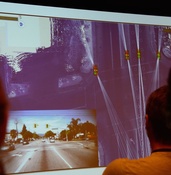
urbansheep@gmail.com
The Trick That Makes Google's Self-Driving Cars Work - Alexis C. Madrigal - The Atlantic - http://www.theatlantic.com/technol...

|
15 мая 2014 в 18:21 с Bookmarklet
Good command or file name
9000
penis mightier than sword
vampire vegetable
smallq
Иван
"Google's self-driving cars can tour you around the streets of Mountain View, California. I know this. I rode in one this week. I saw the car's human operator take his hands from the wheel and the computer assume control. "Autodriving," said a woman's voice, and just like that, the car was operating autonomously, changing lanes, obeying traffic lights, monitoring cyclists and pedestrians, making lefts. Even the way the car accelerated out of turns felt right." • #схватил_за_мозг - × × ×
“Here, we see another Google approach. Dolgov's team uses machine learning algorithms to create models of other people on the road. Every single mile of driving is logged, and that data fed into computers that classify how different types of objects act in all these different situations. While some driver behavior could be hardcoded in ("When the lights turn green, cars go"), they don't exclusively program that logic, but learn it from actual driver behavior. ¶
In the way that we know that a car pulling up behind a stopped garbage truck is probably going to change lanes to get around it, having been built with 700,000 miles of driving data has helped the Google algorithm to understand that the car is likely to do such a thing. ¶
Most driving situations are not hard to comprehend, but what about the tough ones or the unexpected ones? In Google's current process, a human driver would take control, and (so far) safely guide the car. But fascinatingly, in the circumstances when a human driver has to take over, what the Google car would have done is also recorded, so that engineers can test what would have happened in extreme circumstances without endangering the public.” - × × ×
“There is, at least in an analogical sense, a connection between how the Google cars work and how our own brains do. We think about the way we see as accepting sensory input and acting accordingly. Really, our brains are making predictions all the time, which guide our perception. The actual sensory input—the light falling on retinal cells—is secondary to the prior experience that we've built into our brains through years of experience being in the world. ¶
That Google's self-driving cars are using these principles is not surprising. That they are having so much success doing so is.” - × × ×
© 2015 FriendFeed (and Clio archiver)